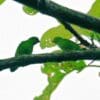Orange-fronted Hanging Parrot
Also known as:
Golden-fronted Hanging Parrot, Misool Hanging Parrot, Papuan Hanging Parrot, Bat Lorikeet
Also known as:
Golden-fronted Hanging Parrot, Misool Hanging Parrot, Papuan Hanging Parrot, Bat Lorikeet
DID YOU KNOW?
The Orange-fronted Hanging Parrot runs its beak along casuarina needles and twigs, apparently searching for lerp (sugar-filled) insects.

Loriculus

aurantiifrons
Size:
10 cm (4 in)
Weight:
13-16 g (0.4-0.5 oz)
Subspecies including nominate:
three: L.a. aurantiifrons, L.a. batavorum, L.a. meeki
Colour Adult:
L.a. aurantiifrons: Male-mainly green in colour; golden/yellow forehead and forecrown; patch on throat red; red rump and upper tail coverts; yellow on sides of rump; green tail tipped with yellow/green. Beak black. Eye yellow/white. Female-blue/green forehead and forecrown; blue wash on cheeks; red patch on throat smaller. Eye brown.
L.a. batavorum: Both adults as in aurantiifrons, but male has less yellow on forehead and forecrown.
L.a. meeki: Both adults as in batavorum, but slightly larger; in female, bases of forecrown feathers paler yellow/brown.
Colour Juvenile:
L.a. aurantiifrons: As in adult female, but red patch on throat absent. Beak pale brown.
Call:
Calls are described as shrill and rapidly repeated, sometimes lengthened into song; also buzzing notes while perched.
More Information:
Content Sources:
CITES
BirdLife International
Cornell Lab of Ornithology/Birds of the World
Parrots: A Guide to Parrots of the World, Juniper and Parr, 1998
Parrots of the World, Forshaw, 2006. 2010 edition
Parrots in Aviculture, Low, 1992.
Lexicon of Parrots, Thomas Arndt.
Captive Status:
Extremely rare.
Longevity:
—
Housing:
Aviary indoors 2.5 x 1 x 2 m (8.2 x 3.3 x 6.5 ft), new birds no less than 25 C (77 F). Strict hygiene necessary.
Diet:
Fruits such as: figs, pear, apple, banana, oranges, cactus fruits; vegetables such as: carrot, celery, green beans and peas in the pod; lory nectar made from: lactose-free baby cereal, honey, molasses or malt extract, and filtered water, made fresh once or twice daily, or commercial nectar; fruit tree (unsprayed) branches with blossoms; small quantities of seed mix of: millet, canary seed, some niger and oats (may be sprouted); millet spray (sprouted).
Enrichment:
Provide plenty of bird-safe, unsprayed flowering branches.
Nest Box Size:
—
Clutch Size:
4
Fledging Age:
—
Hatch Weight:
—
Peak Weight:
—
Weaning Weight:
—
World Population:
Unknown; reported as locally common. Decreasing.
IUCN Red List Status:
Least Concern
CITES Listing:
Appendix II
Threat Summary:
Not globally threatened. Is considered to have a medium dependency on forest habitat, and tree cover is estimated to have declined by 2.2% within its range over the past 10 years. It is tentatively suspected that this may have led to a 1-19% decline in the species’ population over the same period.
Range:
L.a. aurantiifrons: Misool, W Papuan Islands, Indonesia.
L.a. batavorum: Waigeu, W Papuan Islands, and NW New Guinea, east on north coast to Sepik River region, N Papua New Guinea, and on south coast to Setekwa River, West Papua.
L.a. meeki: Fergusson, Goodenough, and Karkar Islands, Papua New Guinea, and E New Guinea, on north coast west to Sepik River region, and in southern lowlands west to Fly River region, and possibly into nearby Irian Jaya.
Habitat:
Found up to 1200 m (3936 ft); rarely 1600 m (5248 ft) in lowland rainforest, along forest edge, in palm plantations, secondary growth, casuarinas, pines, gardens and partly cleared areas.
Wild Diet:
Feeds on buds, fruits, flowers and sugary psyllid lerps.
Ecology and Behaviour:
Not easily seen as it forages in various levels of the canopy. Courtship behaviour may include perching on exposed branches and singing to attract attention. Usually found in groups of 2-4.
Clutch and Egg Size:
Up to 4 eggs.
Breeding Season:
September-October; nest is in small hollow in narrow tree.
Related Links:
—
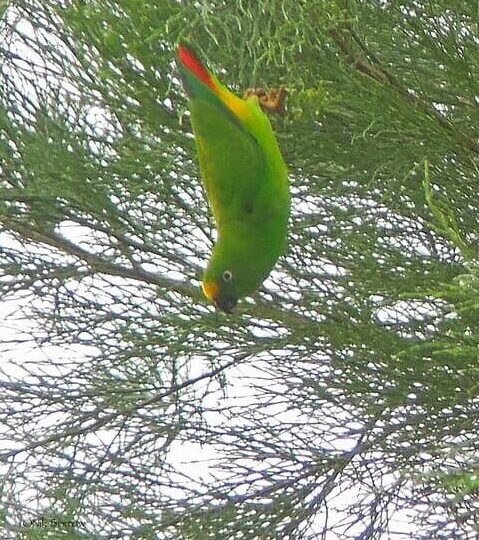
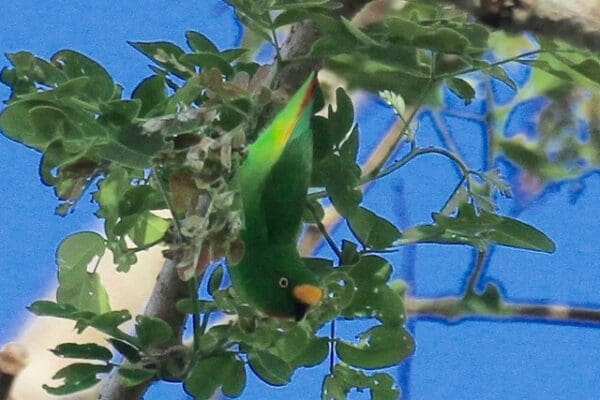
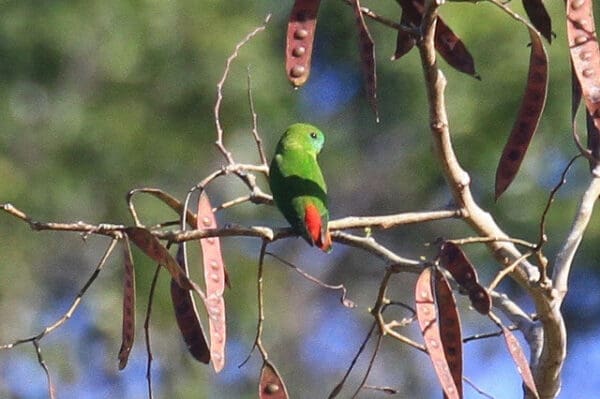
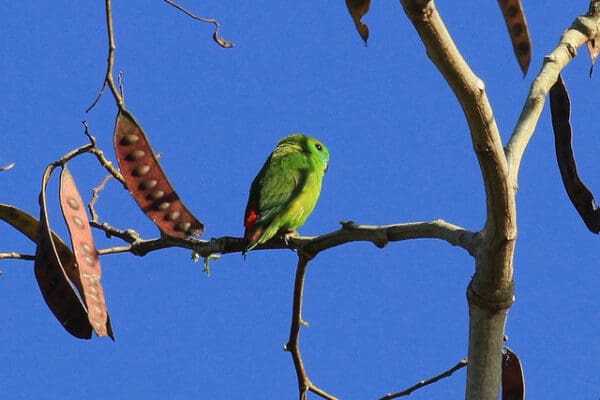
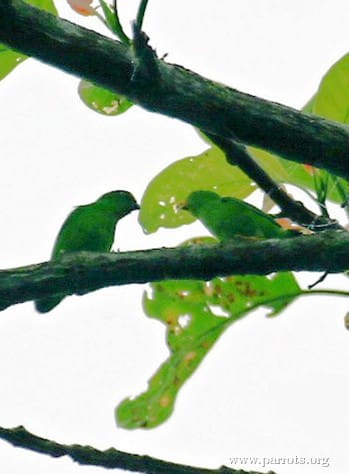
![© Nik Borrow [CC BY-SA 2.0] via Flickr A wild male Orange-fronted Hanging Parrot dangles from a branch](https://parrots.org/wp-content/uploads/2023/01/wpt_Orange-fronted-Hanging-Parrot_1173-3-e1732301197454-100x100.jpg)
![© Charles Davies [CC BY-NC 2.0] via Flickr A wild male Orange-fronted Hanging Parrot dangles from a branch](https://parrots.org/wp-content/uploads/2023/01/wpt_Orange-fronted-Hanging-Parrot_1173-4-100x100.jpg)
![© Charles Davies [CC BY-NC 2.0] via Flickr](https://parrots.org/wp-content/uploads/2023/01/wpt_Orange-fronted-Hanging-Parrot_1173-2-100x100.jpg)
![© Charles Davies [CC BY-NC 2.0] via Flickr A wild Orange-fronted Hanging Parrot perches on a branch](https://parrots.org/wp-content/uploads/2023/01/wpt_Orange-fronted-Hanging-Parrot_1173-1-100x100.jpg)
